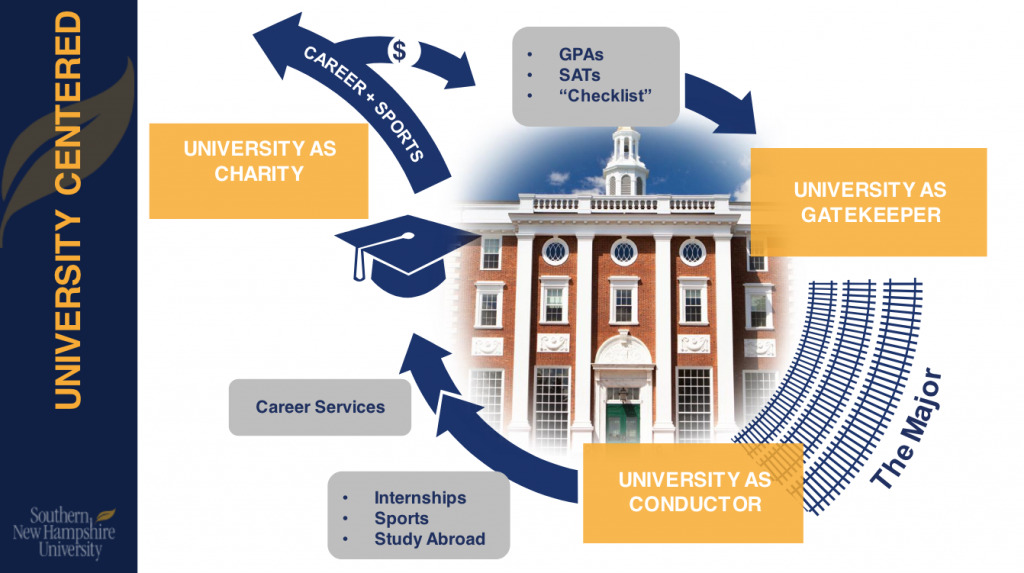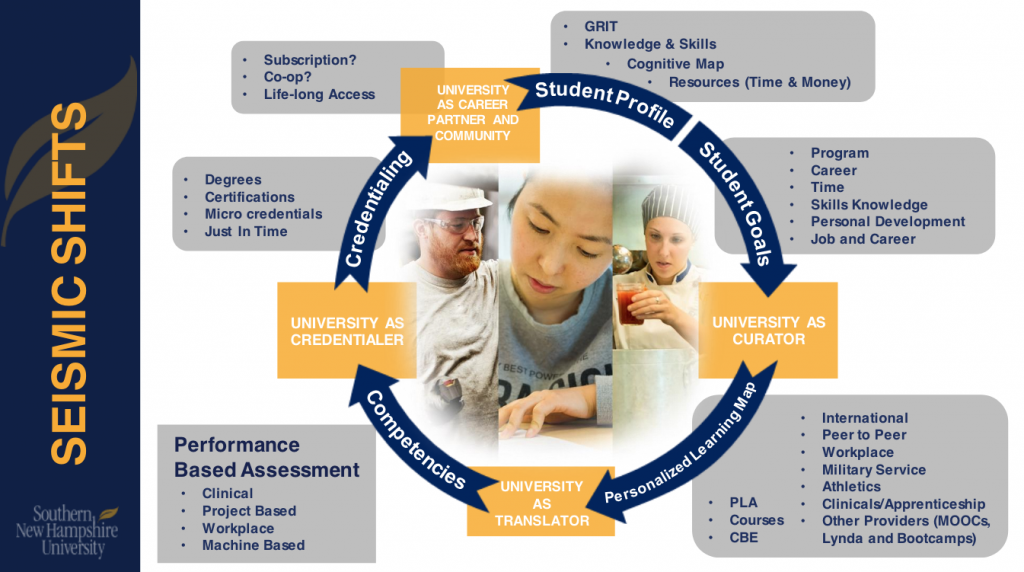Unveiling SNHU’s 2018-2023 Strategic Plan
Posted on October 16, 2018
Strategic planning efforts in higher education usually elicit resigned eye rolling from those who have seen strategic planning as a form of participatory theater, with lots of stakeholders involved and endless meetings and a product that has something for everyone and thus little focus or use. Those plans often sit on a shelf gathering dust and find their best use when someone needs to say to some outside regulatory body, “Yes, of course we have a strategic plan – here it is. See!” To reverse a phrase from Churchill, rarely does the effort of so many result in so little.
We have taken a different approach with our recently released 2018-2023 Strategic Plan (Http://bit.ly/SNHUStrategicPlan). How so?
- We started three years ago with first principle, existential questions such “Why do we exist?” and “What are our core values?” We began with a rethought and revised Mission Statement and adopted a clear and straightforward Vision Statement: “Make the world a better and more just place through our work, one learner at a time.” (I know, not a small vision….)
- We held ourselves accountable to the previous 2013 to 2018 Plan (page 35) and included our report card in the new Plan document.
- We pulled together our best thinking about the current context in which our students live and study (p. 13) and engaged The Institute For The Future to help us think through how the world would be different for our students in 2030 (p. 29, the SNHU 2030 section).
- We developed our Five Commitments (p. 21) and used that term instead of “goals.” People set goals all the time and often fall short of them (e.g. me, every January 1) and we think “commitments” conveys a stronger determination to deliver and a willingness to hold ourselves accountable.
- Each commitment is structured around four areas of effort: strengthening what we do well; innovating for the future; building capacity for our new ambitious goals (to build a platform that allows us to educate 300,000 learners by 2023); and game changing initiatives.
- We talked to everyone we could when we were developing the Plan. Wil Zemp, our Chief Innovation Officer, who also heads our strategy work, deployed his team to work with our unit heads, to socialize earlier drafts, to solicit feedback, and to rewrite and revise.
KPIs have been developed for every functional area of the University, as our business units thought through their role in the plan. We made a copy of the plan for every single employee, since our success in delivering on this plan rests with them; we are entrusting them with making the plan come alive. The task we are setting out for ourselves is to reinvent what a university can be and needs to be for the digital age in which we find ourselves.
I often use this graphic to describe the current model of higher education, which is more institutionally centered than student centered and still largely offers a one-size-fits-all model of learning inspired by the industrial age for which it was largely designed to serve.
In the future, we will become more learner centered, bringing to higher education the same kind of personalized experience that we see happening in so many other industries, including health care.
This shift recognizes that content and its delivery is becoming widely available and increasingly inexpensive (and often free). In that world, the role of the university shifts from content delivery (where we still spend far too much of our time and energy) to curating learning, translating all of those learning experiences, assessing that learning, and certifying what the student has accomplished. In many ways, we might argue that higher education becomes an assessment and certification industry, though the curation of learning remains an important function (the DIY grazing model works for just a tiny percentage of students). This is a fundamental shift, of course, but all of the component parts of what we envision exist today and our plan calls for us to move in this direction.
Related to the plan, the questions I hear most often are “So what’s your target for growth? How big do you want to get?” People generally want a number, but the number for me is a by-product of our work. If we reach 300,000, 500,000 or 750,000 students, we would still be serving only a small slice of the current market of college students and not making a real dent in the bigger problem, the tens of millions of Americans who have some credits, but no degree (though often debt), the tens of millions who never started a college degree, the tens of millions that will need to retool as we see massive job displacement from artificial intelligence and automation, and the even greater need globally.
So I don’t look to a number, I look for signs that we are slipping in our commitment to student success, that we stop following our “always do the right thing” credo, that we start to slip in our systems and capacity. Most importantly, that students continue to feel like they are getting personalized support and that we treat them as individuals deserving our best effort and not as a number, no matter the total overall number of students being served. If any of those goals start to slip, we will be the first to hit the pause button and get things right again.
However, as long as we can stay true to our values and mission, we will seek to educate students wherever they are and whereever they need us. This is true today with our parents juggling work and family with their studies, with our veterans and military families, with our DACA students, with our on-campus students, with our refugee students, with the homeless kids in our RISE High partnership, and the tens of thousands of SNHU students who choose us as their university.
Increasingly, our work will have us reach “upstream” to serve more pre-college students and “downstream” to serve more workers and adults long past traditional college age. We envision a learning platform really, in and out of which people will go to get just the right learning at just the right time in just the right way for their needs, over the course of a career and a lifetime. A platform that is as comfortable with an 11th grader working on an associate degree as a 60-year-old working on a high school degree. One that continues to offer conventional college degrees, but also badges, micro-credentials, and more options of credentials offered in more modalities, eventually evolving to highly curated and personalized learning pathways.
In our recent ten-year accreditation, our planning was singled out for high praise. Board members asked for extra copies to bring back to their organizations. Barbara Brittingham of NECHE asked us to share the plan. We made a decision to make the plan available to the public, including our competitors. This plan is our roadmap for the future.

